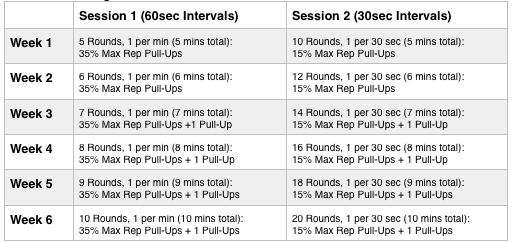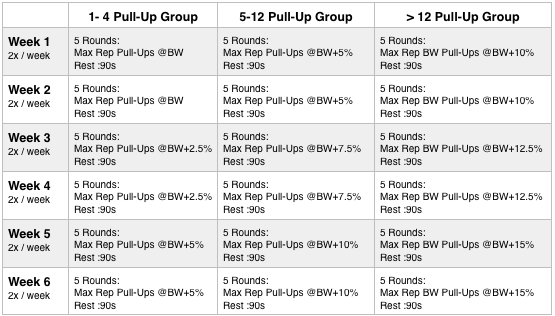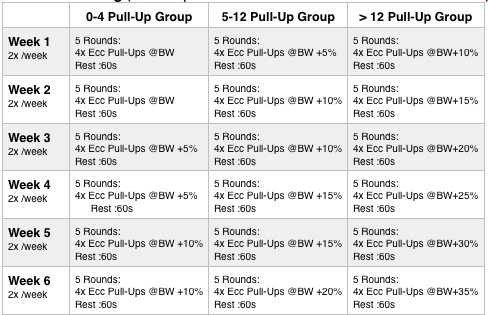Adam Scott, MS, CSCS
Last week marked the end of our 6-week 3 method pull-up training experiment. So, on Tuesday we conducted our post-cycle assessment to see how our athletes (and the 3 training methods) stacked-up.
Methods (Quick Summary):
Six weeks ago we divided our athletes into 3 pull-up training groups: (1) Volume Pull-Up Training, (2) Weighted Pull-Up Training, and (3) Eccentric Pull-Up Training. Within each group we categorized our athletes based on their initial pull-up scores so that we could scale their training (0-4 Reps, 5-12 Reps and greater than 12 Reps).
Each group trained pull-ups twice a week for 6 weeks (as part of their regular training program). At the end of 6 weeks, we retested each athlete and compared the three training methods.
Results:
Volume Training Group:
Results: Of the 11 athletes which were initial assigned to this group we were able to re-test 8. All 8 of the retested athletes showed improvement in their pull-up scores.
These 8 athletes averaged 9.9 pull-ups on their initial test (5/20) and 14.5 on their retest (6/30). This accounted for an average increase of 4.6 pull-ups in six weeks. The 3 athletes who did not retest were dropped from the data.
Training Observations: Our volume training consisted of 60 sec. and 30 sec. intervals. We started our athletes at 5 minutes and progressed to a full 10 minutes of pull-up training, twice a week.
We had originally planned to progress training by adding time (1 minute per week) and by adding reps (1 rep every 2 weeks). However, by week 4 we noticed that our training design was becoming too intense and decided to scale back weeks 5 and 6. This meant our training volume peaked at 350% +10 reps on Tuesday and 300% +20 reps on Thursday (percent is based on the athlete’s Maximum Repetition Initial Test).
Weighted Pull-Up Training Group:
Results: Because we divided our athletes based by their pre-existing training groups the Weighted Pull-Up Group only consisted of 3 regular athletes. This unfortunately makes their data less reliable and far more difficult to generalize.
However, we were able to reassess all 3 athletes during the cycle and did not have to drop any from our data pool. The 3 athletes averaged 15 pull-ups on the initial test (5/20) and 16.3 on the final test (6/3). Their individual changes ranged from -1 to +4 pull-ups in 6 weeks.
Training Observations: All of the athletes in the weighted training group were in the highest category during the initial assessment (>12 Pull-Ups) so they began their weighted training at 10% over body weight and progressed to 20% over body weight during week 5 and week 6.
As I mentioned during the mid-cycle assessment I believe the biggest problem this group faced was the decrease in rep volume as we added weight. In my opinion this shows that we were probably too quick to add weight and should have spend more time at each progression.
Take a look for your self, we tracked each athlete’s total reps during their 5 sets and this is how they performed week-to-week.
* Note: No increase in weight during week 5 and 6.
Eccentric Training Group:
Results: In the end we had 8 athletes who completed the initial test and retest. Unfortunately this means we had to drop 3 athletes from our data. All three of these athletes were in the 0-4 Rep Initial Pull-Up Group.
As I mentioned in the mid-cycle article, assessment results from this group are difficult to interpret – plus, losing 3 of our athletes (especially from the 0-4 Rep training group) was very unfortunate.
The remaining 8 athletes had an initial average score of 7.8 pull-ups (5/20) and a retest score of 11.3 pull-ups (6/30). This equals an average increase of 3.5 pull-ups in 6 weeks.
Still, perhaps the most exiting result was that, of the 5 athletes who started training at 0 reps, 2 completed their first pull-up after only 6 weeks. Unfortunately the other three athletes were not able to retest (one transferred to anther training group, one was injured and the other was absent for the retest).
Observations: Eccentric pull-up training is tough for even high performing athletes. We found that our scheme of four reps at 5 seconds each is probably too high to start for athletes with low initial scores. Our athletes were able to adjust, but we recommend probably starting at 2-3 reps max.
Also, because of the intense muscle damage that can be caused by eccentric training I think athletes should spend an additional sessions or two at each progression before transitioning.
For the higher scoring athletes a quicker weight increase appeared to work fine, but for the athletes starting at zero reps the focus should be on completing quality repetitions which allow the athlete to work the full range of motion.
Discussion:
We designed this experiment to investigate a number of basic questions we had concerning pull-up training. While we can’t definitively say that we answered everything, we can make a few generic (and specific) recommendations – especially concerning our population of athletes.
Obviously we would have preferred more subjects, and ideally we would have been able to randomize and control the groups a little better, but this is “weight room functional” research, so we work with what we have. And based on what we observed I think we have some interesting insights to offer.
Volume Training:
Our Volume Training Group proved to be our most successful of the three groups. Athletes in this group saw nearly 50% improvement in their pull-up scores.
However, it is important to note that all athletes in this group had initial scores of between 4 and 12 pull-ups. While this had no effect on their training protocols, these scores did classify the entire Volume Training Group as “moderate” pull-up performers at the start of the study – which left plenty of room for improvement.
Final scores ranged from 8 to 22 pull-ups with all but 2 of the athletes above the 12 pull-up standard we used to identify higher performers.
Weighted Training:
Our Weighted Training Group saw the least amount of improvement over the six weeks. As I discussed in the mid-cycle article I think this is more a product of our training protocols than a total indictment of weighted pull-up training.
The weighted group saw a moderate increase from 15 to 16.3 pull-ups (8.9%).
There are a few important factors to consider when looking at these results: (1) The size of the group – 3 athletes is too few to draw any broad conclusions, (2) All 3 athletes scored in the the highest group during their initial test – the fact that they were already scoring well meant that they likely had less room to improve, and (3) The low training volume the athletes experienced because of the higher weights.
Taking into consideration these three factors it is difficult to definitively say that weighted pull-up training is less effective than the other two. However, it does seem to suggest that the volume of training (total reps) is an important factor to consider.
Eccentric Training:
Eccentric Training was our wild card. This was the first time we have employed eccentric training for pull-ups and we weren’t sure what to expect.
Again, it would have been great to have more subjects, but, never-the-less, I think our results are pretty exciting. Every athlete we were able to retest in this group saw improvements. From the high performers to the 0-rep athletes, eccentric training seems to be an effective way to train for pull-ups.
In a matter of 6 weeks we saw 2 of our 5 athletes go from 0 to 1 pull-up and, had we been able to test the other 3, I have no doubt we would have seen at least 1 more athlete make the jump.
The one downside is that we didn’t have more moderate and high performers to test. The eccentric group had only one moderate performer (4 pull-ups to 7 pull-ups) and one high performer (34 pull-ups to 42 pull-ups). It would have been nice to have more athletes in these ranges to get a better feel for the programming.
So, ultimately what is the best method for improving Pull-Ups?
I am going to be a little diplomatic here and give you two answers:
Volume Based Training – If an athlete is already able to perform a pull-up the key to improving their pull-up performance seems to be doing lots of pull-ups in training. Based on the protocols we used, volume-based, unweighted training is likely the best way to improve scores for a moderate to moderately-high performer (somewhere in the 4-15 pull-up range).
And honestly, this answer makes sense – if you want to get better at body weight pull-ups you need to do lots of body weight pull-ups. I also think that the protocols we used for our volume training were highly effective at generating quality reps and high volumes – both 60 second intervals and 30 second intervals seem to work well.
With that said, I am not completely ready to discount weighted training. I think that weighted training could still be an effective way to increasing body weight pull-ups, but the additional weight would have to be moderated so that volumes can remain high.
Eccentric Training – For athletes who are starting at 0 reps eccentric training seems to be very effective. It is tough to say that eccentric training is the best way to train for pull-ups since we didn’t test any others with the 0-rep group, but I am more than comfortable saying that it works.
Since a 0-Rep Athlete doesn’t have the option of training multiple rounds of body weight pull-ups we found a great alternative – one which allows them to immediately be 20-30% stronger and still work the same movement patter (just in reverse) – Eccentric Training.
The key for us was moderating the additional weight to ensure our athletes worked the full range of motion and completed quality reps. I am still open to the notion that other training methods might help (isometric training, dead hangs, scapular activation, rows, etc.). But, in the end, to have 2 of 5 (and possibly more) athletes make the jump from 0 pull-ups to 1 pull-up in just 6 weeks is enough for me.
Add one of the training protocols to your program and let us know what you think. Here are the updated versions we used. Send your thoughts to adam@strongswiftdurable.com.
Volume Training:
Weighted Training
Eccentric Training (Each Rep includes a 5 second descend and 5 second rest)
You Might Also Like MTI’s 3-Week Push-Up & Pull Up Improvement Training Plan





